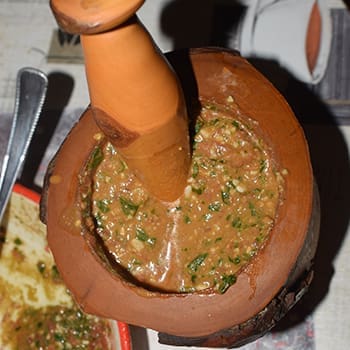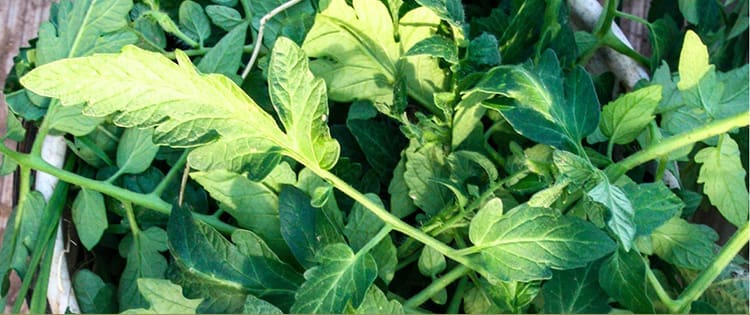Every summer, we gardeners find pride in the abundance of juicy, sweet, and tangy fruit our tomato plants give. Harvest after harvest, we indulge in all things tomato! Some of us conserve our tomatoes for later use by making and canning tomato sauce, freezing diced tomatoes, or even dehydrating tomatoes so that we can enjoy the fruit year-round. But did you know that the Tomato plant doesn’t limit its useful (and tasty) abundance to the fruit? Tomato leaves are a forgotten treasure.
Tomato Leaves In The Kitchen
You will find the most useful tomato leaves in your kitchen.
There is an old wives tale that has many believing that tomato leaves are poisonous. On the contrary! They are 100% edible and delicious! Tomato leaves deserve use in your home cuisine. The leaves are highly fragrant and carry a faint tomato flavor. They are also slightly bitter greens, less so than arugula.
Let’s have a look at a few ways you can incorporate Tomato leaves into your favorite homemade dishes.
Salad
One of the easiest ways to incorporate tomato leaves into your meal is by incorporating them in a salad. When using tomato leaves in a salad, it’s best to pick and use young tomato leaves, as they are much more tender and less meaty. The Fragrance of the leaves and slight tomato flavor will help elevate a simple mix of greens.
Sautée
Tomato leaves make for an excellent sautée. Whether you mix them with other leafy greens or fry them on their own with salt and olive oil, they make for a scrumptious side dish.
Pesto
Tomato leaves make for a fantastic homemade pesto. Place your clean tomato leaves, oregano, and garlic in a blender and form into a paste (or go the traditional route and use a pistol and mortar). Once the first step is complete, add in a bit of extra virgin olive oil and lemon and salt to taste.
Feel free to experiment with this basic recipe!
At our house, we regularly make pesto using tomato leaves, nuts from our own nut trees, such as walnuts, and local hard goat cheese. There are so many combinations of pesto to try and several ways to eat it. We enjoy using our tomato leaf pesto in pasta, salads, bruschetta, etc.
Stews and Soups
Tomato leaves also make for a great green to add to your favorite stew and soup recipes. The leaves can easily replace the leafy greens you may use in these dishes, such as kale, spinach, and cabbage. Of course, mixing them in with other greens is an easy way to give a bit of savory flavor to your favorite stewpot recipes.
Tea
Tomato leaf tea, anyone?
Even more surprising for people who are unfamiliar with using tomato leaves in the kitchen, they make for a wonderful tea! Whether used fresh or dry, tomato leaves give earthy notes to herbal tea blends and, of course, a distinct aroma to give a simple herbal blend a bit of a twist. My personal favorite homemade herbal tea is a mix of tomato leaf, camomile, and mint.
Tomato Leaves For you Skin
Nowadays, we are seeing more and more high-end skincare products hitting the shelves touting their use of the almighty tomato! Indeed Tomato carries a long list of benefits for your skin. Amongst the most sought-after benefit of tomatoes in skin care is the high Vitamin C. Vitamin C helps to fight signs of aging by helping to firm the skin, reducing the appearance of wrinkles.
However, skincare benefits do not stop with the fruit itself. Tomato leaves are also a powerhouse ingredient in skincare.
Firms and Lightens
Tomato leaves are also rich in Vitamin C and very effective in reducing wrinkles, lightening dark spots, and the appearance of acne scars. One way to use tomato leaves at home is by making a glycerine-based tincture with tomato leaves and other soothing and age-fighting herbs such as camomile, rose, and rosemary.
Anti-Inflammatory
Moreover, when made into a pulse, tomato leaves act as an efficient anti-inflammatory for troublesome acne.
Anti-Fungal
The leaves are also a powerful antifungal and can assist in clearing fungal conditions, such as athlete’s foot.
Tomato Leaves In The Garden
Tomato leaves can be used in a variety of useful ways in your garden. They are great at helping to balance the PH levels of your compost, fighting off insects, and treating common plant diseases.
In Your Compost
Like other leafy, edible greens, tomato leaves are rich in nitrogen, making them a great addition to your compost. To get the best out of your tomato leaves, be sure to cut them down to a mulch before adding them to your compost.
Natural Insecticide
Tomato leaves make for an effective natural insecticide as well. The solanine, tomatin, and even nicotine found in tomato leaves are natural insect repellents. When tomato leaves are chopped up and soaked in water overnight, the water can be drained and placed in a spray bottle for use in your garden. This spray can be used on plants where you are experiencing the most trouble and work wonders against aphids.
Tomato Leaves For Black Spots
Rose lovers are no strangers to pesky Black Spot, the most common disease for roses. Black Spot is caused by the Diplocarpon Rosae fungus that will begin to attack rose leaves on your plant, greatly reducing growth and flowering. Tomato leaves prepared and used in the same manner as the natural insecticide mentioned above have proven to be effective in treating the disease.
One of the best moments to collect tomato leaves is when you are pruning your plants. So next summer, don’t forget to take advantage of the abundance of tomato leaves that your plant gives. Whether you are incorporating tomato leaves into your favorite dishes, creating cream, pulses, or tinctures to cure skin ailments and combat signs of aging, or using them in the garden, these leaves are sure to find a useful place in your life.
You may also like:
10 Tomato Growing Tips For Beginners
Here’s The Easiest Way To Tell Apart Edible Plants and Their Poisonous Lookalikes (Video)
Wild Edibles You Should Forage This Fall
How To Repurpose Old Items Into New Projects For Your Backyard










